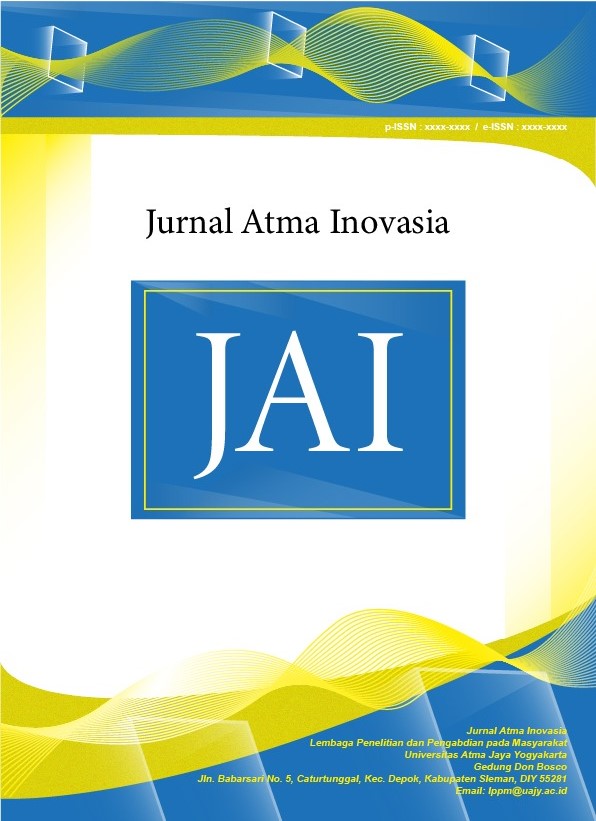Perancangan Landskap dan LP3S Wisma Widya Graha di Salatiga dengan Pendekatan Biofilik
DOI:
https://doi.org/10.24002/jai.v4i6.9921Keywords:
biofilik, keberlanjutan, perancangan lanskap, vegetasiAbstract
Perancangan lanskap dan LP3S Salatiga Wisma Widya Graha menggunakan pendekatan biofilik untuk memaksimaklan penataan ruang yang efsisien, dengan memperhatikan konektivitas antar ruang luar tanpa mengganggu aspek privasi maupun faktor luar serta menciptakan ruang luar yang efisien dengan dominan memanfaatkan vegetasi sebagai aspek yang ingin ditonjolkankan dalam perancangan. Pendekatan biofilik yang didukung oleh konsep keberlanjutan diwujudkan dalam perancangan melalui pemanfaatan aksesibilitas utama pengunjung dan pedestrian, upaya mempertahankan penutup tanah dan lapangan perindang, penggunaan tanaman perdu sebagai dekorasi dan penggunaan tanaman produktif, mengoptimalkan pemandangan taman yang hijau dan asri, serta mempertahankan tipologi wisma sebagai penginapan dan kegiatan yang dapat memberikan pengalaman ruang lanskap dalam bentuk area terbuka hijau dengan pemandangan dan suasana lingkungan.
References
[1] LP3S, “LP3S Salatiga,” https://lp3s.org. [Online]. Available: https://lp3s.org. [Accessed: 14-Feb-2024].
[2] M. Alam, “Biophilic architecture and designs for mental well-being,” IOP Conf. Ser. Earth Environ. Sci., vol. 1218, no. 1, 2023.
[3] E. Hassankhouei, “Biophilic Design in Architecture : Impacts on Well-being,” vol. 44, no. 6, pp. 5817–5831, 2023.
[4] V. Kabinesh et al., “Sustainable Spaces - The Evolution of Biophilic Design in Modern Architecture: A Review,” Asian J. Environ. Ecol., vol. 23, no. 5, pp. 64–77, 2024.
[5] G. Zare, M. Faizi, M. Baharvand, and M. Masnavi, “A Review of Biophilic Design Conception Implementation in Architecture,” J. Des. Built Environ., vol. 21, no. 3, pp. 16–36, 2021.
[6] Y. Zhao, Q. Zhan, and T. Xu, “Biophilic Design as an Important Bridge for Sustainable Interaction between Humans and the Environment: Based on Practice in Chinese Healthcare Space,” Comput. Math. Methods Med., vol. 2022, 2022.
[7] W. Zhong, T. Schröder, and J. Bekkering, “Biophilic design in architecture and its contributions to health, well-being, and sustainability: A critical review,” Front. Archit. Res., vol. 11, no. 1, pp. 114–141, 2022.
[8] Y. Wang, F. Bakker, R. de Groot, H. Wortche, and R. Leemans, “Effects of urban trees on local outdoor microclimate: synthesizing field measurements by numerical modelling,” Urban Ecosyst., vol. 18, no. 4, pp. 1305–1331, 2015.
[9] W. M. El-Bardisy, M. Fahmy, and G. F. El-Gohary, “Climatic Sensitive Landscape Design: Towards a Better Microclimate through Plantation in Public Schools, Cairo, Egypt,” Procedia - Soc. Behav. Sci., vol. 216, no. October 2015, pp. 206–216, 2016.
[10] S. Teshnehdel, H. Akbari, E. Di Giuseppe, and R. D. Brown, “Effect of tree cover and tree species on microclimate and pedestrian comfort in a residential district in Iran,” Build. Environ., vol. 178, no. January, p. 106899, 2020.
[11] B. K. Suryantara, J. A. Suryabrata, and A. R. Suryandono, “The Effect of Vegetation in Various Canyon Geometry on The Thermal Comfort of Jakart,” J. Archit. Res. Des. Stud., vol. 2, no. 2, 2019.
[12] J. H. Rhee, B. Schermer, G. Han, S. Y. Park, and K. H. Lee, “Effects of nature on restorative and cognitive benefits in indoor environment,” Sci. Rep., vol. 13, no. 1, pp. 1–10, 2023.
[13] F. Binarti, S. Triyadi, M. D. Koerniawan, P. Pranowo, and A. Matzarakis, “Climate characteristics and the adaptation level to formulate mitigation strategies for a climate-resilient archaeological park,” Urban Clim., vol. 36, no. November 2020, p. 100811, 2021.
[14] S. Tsoka, T. Theodosiou, K. Tsikaloudaki, and F. Flourentzou, “Modeling the performance of cool pavements and the effect of their aging on outdoor surface and air temperatures,” Sustain. Cities Soc., vol. 42, no. July, pp. 276–288, 2018.
[15] F. Abbondati and L. Cozzolino, “Porous Pavements in the Context of Sustainable Urban Design Concerns,” ARPN J. Eng. Appl. Sci., vol. 15, no. 20, pp. 2327–2335, 2020.
[16] I. Abustan, M. O. Hamzah, and M. A. Rashid, “Review of permeable pavement systems in Malaysia conditions,” OIDA Int. J. Sustain. Dev., vol. 4, no. 02, pp. 27–36, 2012.
[17] B. P. Statistik, “Data Kota Salatiga,” 2024. [Online]. Available: https://salatigakota.bps.go.id/id. [Accessed: 25-Mar-2024].
Downloads
Published
Issue
Section
License
Copyright (c) 2024 Rony Gunawan Sunaryo, Angelique Widya Bulandari, Stellia Amalinda, Dionisius Bayu Dewanto, Budhi Benyamin Lilly, Floriberta Binarti

This work is licensed under a Creative Commons Attribution-ShareAlike 4.0 International License.










